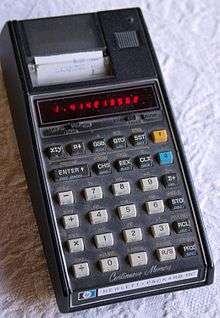HP-19C/-29C


The HP-19C and HP-29C were scientific/engineering pocket calculators made by Hewlett-Packard between 1977 and 1979. They were the most advanced and last models of the "20" family (compare HP-25) and included Continuous Memory (battery-backed CMOS memory) as a standard feature.
The HP-19C included a small thermal printer, one of the very few hand-held scientific calculators to offer such a feature (the HP-97 was a desktop unit, and later models like the HP-41C only supported external printers). Due to the printer's power requirements, the 19C used a battery pack of four AA-sized NiCd cells, adding to the weight of the calculator and printer mechanism.
All other capabilities were the same in both models – RPN expression logic, 98 program memory locations, statistical functions, and 30 registers.
Users could develop software for the HP-29C/19C, such as a prime number generator.[1] The calculators expanded the HP-25's program capabilities by adding subroutines, increment/decrement looping, relative branching and indirect addressing (via register 0 as index).
HP's internal code name for the 29C was Bonnie, the 19C was correspondingly named Clyde.
The HP-19C and HP-29C were introduced at MSRPs of $345[2] and $195,[3] respectively.
External links
Simulators and emulators
- HP-29C simulator for Windows
- HP-19C and HP-29C emulators for Windows
Notes
- ↑ Aslan, Wilfred (1980-10-01). "Prime Numbers on the HP-19C". BYTE. pp. 54–58. Retrieved 2015-12-21.
- ↑ $345 in 1980 ≈ $910 in 2010 (see Inflation Conversion Factors for Dollars)
- ↑ $195 in 1980 ≈ $510 in 2010 (ibid.)